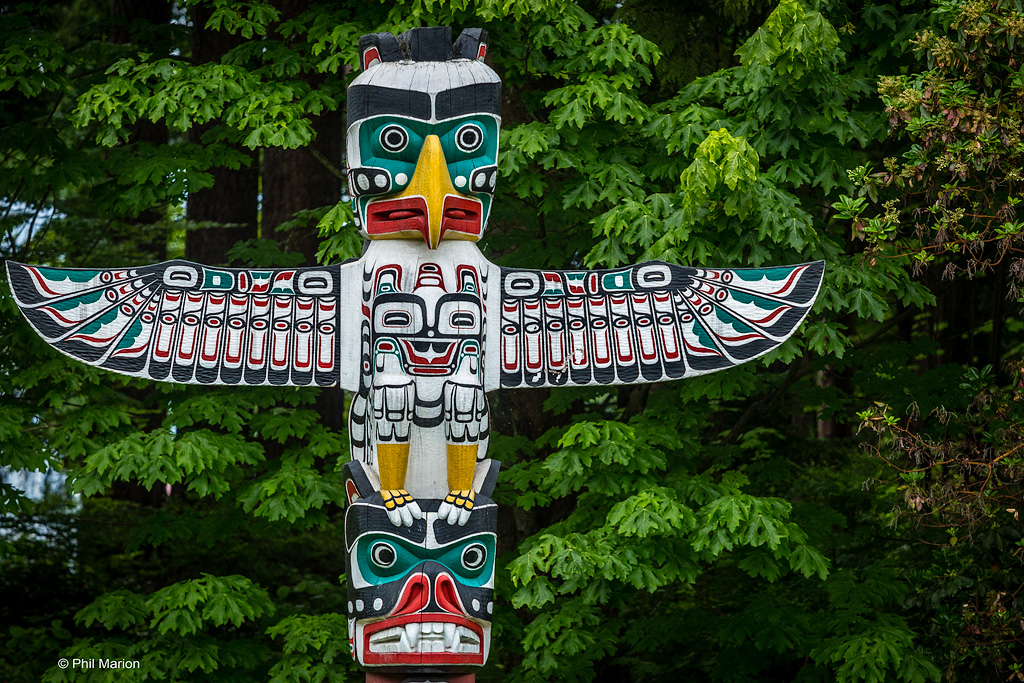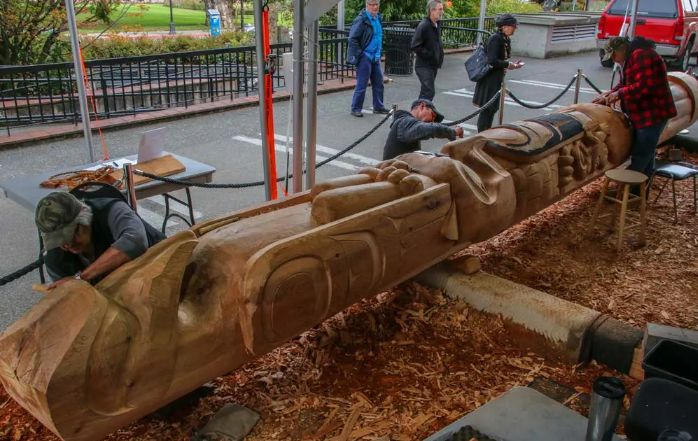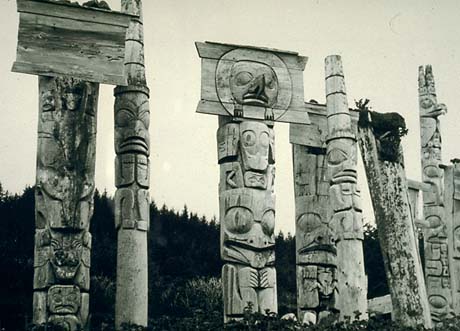Introduction
Canadian Indigenous totem poles are captivating expressions of a rich cultural heritage. These towering wooden sculptures, intricately carved and adorned with vibrant colors, have fascinated people from around the world for centuries. In this in-depth exploration, we’ll delve deep into the world of Canadian Indigenous totem poles, exploring their history, cultural significance, carving techniques, and their enduring presence in Canadian Indigenous communities.
I. Origins and Diversity
The origins of Canadian Indigenous totem poles are rooted in the diverse cultures of the Pacific Northwest, including the Haida, Nuu-chah-nulth, Coast Salish, and Tlingit tribes. Each tribe brings its unique artistic style and traditions to the rich tapestry of totem pole artistry.

- Haida Totem Poles: The Haida people, renowned for their artistic prowess, craft totem poles characterized by bold designs, monumental size (sometimes exceeding 60 feet), and striking symmetrical patterns. These totem poles often depict a fascinating array of animals, humans, and mythical creatures, each with its own symbolic significance.
- Nuu-chah-nulth Totem Poles: For the Nuu-chah-nulth tribes, their totem poles are intimately connected to their maritime culture. These sculptures frequently feature scenes of whaling, fishing, and marine life, reflecting the deep spiritual bond these communities have with the ocean and its resources.
- Coast Salish Totem Poles: Coast Salish totem poles are characterized by their simplicity and elegance. Often incorporating geometric shapes and subtle carvings, these totem poles convey a sense of tranquility and beauty, reflecting the region’s natural landscape.
- Tlingit Totem Poles: Tlingit totem poles stand out for their intricate storytelling. These towering sculptures serve as visual records of clan stories and family histories, making extensive use of detail and moveable parts to enhance their narrative capabilities.
II. Cultural Significance
The cultural significance of Canadian Indigenous totem poles transcends their role as mere artworks; they are the cornerstone of Indigenous spirituality, social structure, and identity.
- Cultural Preservation: Totem poles are not static sculptures but living narratives. They serve as storytelling devices, passing down tribal histories, traditions, and knowledge from one generation to the next. In this way, they ensure the continuity of cultural heritage, preserving Indigenous wisdom and teachings.
- Community Cohesion: Erecting a totem pole is often a communal effort that strengthens the bonds within Indigenous communities. The process of carving and raising a totem pole involves the active participation of numerous community members, forging a sense of unity and shared purpose.
- Potlatches: Potlatches, traditional ceremonies among Indigenous peoples, often involve the presentation of gifts and the raising of totem poles. These events serve as a means of wealth redistribution, cultural expression, and the reaffirmation of social hierarchies, making them integral to the cultural fabric of Indigenous communities.
III. Carving Techniques and Symbolism

The art of carving totem poles is a highly specialized craft that requires both skill and spiritual understanding.
- Cedar Wood Selection: The choice of cedar wood is not arbitrary; it holds deep cultural significance. Cedar is considered a sacred tree, symbolizing longevity and strength. Its selection for totem pole carving is both practical and spiritual, embodying the spirit of the forest and the enduring traditions of Indigenous cultures.
- Symbolic Representation: Totem poles are not random assemblies of figures; they are meticulously planned representations of cultural and spiritual significance. The specific placement and arrangement of figures on a totem pole convey messages. The lower portion often features the most important figures, while the upper portion may include the creator figure or other powerful beings.
- Painting and Colors: The vibrant colors adorning totem poles are derived from natural pigments, such as red ochre and black from charcoal. These colors are not merely decorative but carry additional layers of symbolic meaning, enhancing the totem’s visual impact and narrative depth.
IV. Preservation and Revival
Preserving and reviving the tradition of totem pole carving are essential to safeguarding this cultural heritage for future generations.

- Conservation Efforts: The harsh weather conditions of the Pacific Northwest can take a toll on totem poles. Conservationists employ various methods to protect these cultural treasures, from applying protective coatings to providing controlled environments that mitigate the impact of the elements.
- Education and Apprenticeships: Indigenous communities actively engage in passing on the tradition of totem pole carving to younger generations. Through apprenticeships and educational programs, they ensure that the art form remains alive and vibrant, with the knowledge and skills being transferred from one generation to the next.
- Contemporary Expression: Totem pole carving continues to evolve in the hands of contemporary Indigenous artists. They push the boundaries of tradition, exploring new themes, incorporating modern materials, and addressing contemporary issues such as environmental conservation and cultural revitalization. This blending of tradition and innovation ensures that totem pole carving remains a dynamic and evolving art form.
Conclusion
Canadian Indigenous totem poles are not just art; they are history, stories, and spiritual connections. By preserving and supporting this heritage, we honor the past, embrace the present, and empower future generations to carry forward the legacy of these majestic works of art. The totem poles stand as a testament to the resilience, creativity, and cultural richness of Indigenous peoples, inviting us to explore the depth of their heritage.

